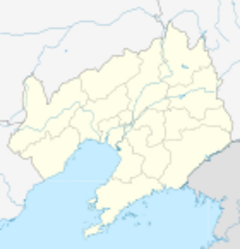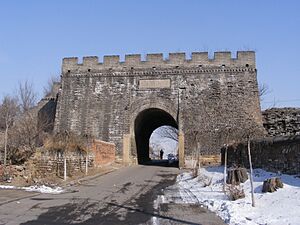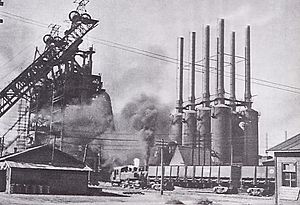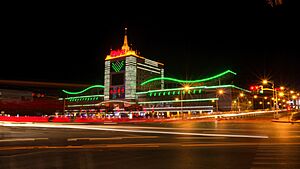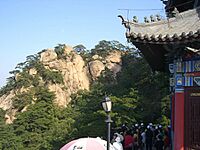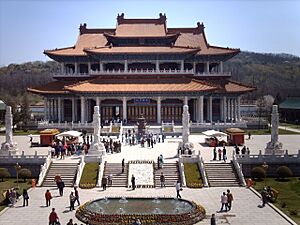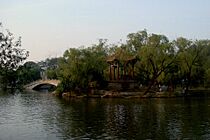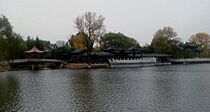Anshan facts for kids
Quick facts for kids
Anshan
鞍山市
|
|
|---|---|
|
Prefecture-level city
|
|
|
Left to right, top to bottom: Anshan skyline, the Jade Buddha Palace, Anshan Iron and Steel Works, the Anshan railway station, Lishan Temple
|
|
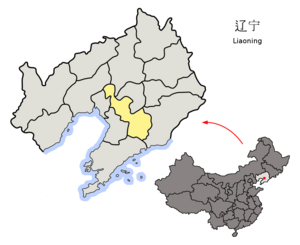
Location of Anshan City jurisdiction in Liaoning
|
|
| Country | People's Republic of China |
| Province | Liaoning |
| Municipal seat | Tiedong District |
| Districts and Counties |
List
Tiedong District
Tiexi District Lishan District Qianshan District Haicheng City Tai'an County Xiuyan Manchu Autonomous County |
| Area | |
| • Prefecture-level city | 9,270 km2 (3,580 sq mi) |
| • Land | 8,563 km2 (3,306 sq mi) |
| • Water | 689 km2 (266 sq mi) 7.4% |
| • Urban | 794.9 km2 (306.9 sq mi) |
| • Metro | 3,997.8 km2 (1,543.6 sq mi) |
| Highest elevation | 1,141 m (3,743 ft) |
| Lowest elevation | 2 m (7 ft) |
| Population
(2020 census)
|
|
| • Prefecture-level city | 3,325,372 |
| • Density | 358.72/km2 (929.1/sq mi) |
| • Urban | 1,543,696 |
| • Urban density | 1,942.00/km2 (5,029.8/sq mi) |
| • Metro | 2,712,789 |
| • Metro density | 678.570/km2 (1,757.489/sq mi) |
| GDP | |
| • Prefecture-level city | CN¥ 233.7 billion US$ 37.5 billion |
| • Per capita | CN¥ 64,710 US$ 10,389 |
| Time zone | UTC+8 (China Standard) |
| Postal code |
114010
|
| Area code(s) | 412 |
| ISO 3166 code | CN-LN-03 |
| Licence plates | 辽C |
| Administrative division code | 210300 |
| Website | Anshan.gov.cn |
Anshan (Chinese: 鞍山; pinyin: Ānshān; literally "saddle mountain") is a big city in central-southeast Liaoning province, China. It's about 92 kilometers (57 miles) south of Shenyang, the provincial capital. In 2020, Anshan had a population of over 3.3 million people. This makes it Liaoning's third largest city.
The city's name, "Anshan," means "saddle mountain." It comes from a nearby mountain that looks like a horse saddle. You can see this mountain when you're on the train heading north to Anshan railway station. Anshan is famous for the Anshan Iron and Steel Group, which is one of China's biggest steel makers. Anshan is also a sister city with Sheffield in the United Kingdom.
Anshan has a lot of natural resources. It holds one-third of the world's supply of talcum and a quarter of the world's magnesite. The city is also home to the largest jade stone ever found. This huge stone is now a local tourist attraction, carved into a Buddha statue.
Contents
- Anshan's Past: A City of Iron and Steel
- Anshan's Location and Environment
- Anshan's City Layout: Districts and Counties
- Anshan's Economy: China's Steel Capital
- Anshan's People: A Diverse Community
- Getting Around Anshan: Transportation Links
- Anshan's Tourist Attractions: Fun Places to Visit
- Learning in Anshan: Universities
- Famous People from Anshan
- See also
Anshan's Past: A City of Iron and Steel
People have lived in the Anshan area for a very long time, since prehistoric times. They have been mining iron and working with metals here for over 2,000 years. For a long time, Anshan was a small city, not as important as nearby Liaoyang. This changed in the mid-20th century.
In 1587, the Ming Dynasty built defenses in Anshan to protect against the growing power of the Manchu people. The city was burned down during the Boxer Rebellion and again during the Russo-Japanese War (1904–1905). After this war, Japan gained influence in the region and started building industries. Anshan was located along the new South Manchuria Railway line, which connected the port of Dalian to the big city of Shenyang.
Japanese Control and World War II
From 1918 to 1945, Japan controlled Anshan. It became a major center for making iron and steel. After Japan occupied northeast China in 1931, the steel mills became a Japanese-owned company called Showa Steel Works. Anshan grew much larger around this new industrial area. It became one of the biggest producers of iron and steel in Asia.
Because of its importance, Anshan was a target during World War II. American B-29 Superfortress bombers attacked the city several times. Even though Japanese planes tried to defend the factories, the plant was badly damaged.
After World War II: Rebuilding and Growth
After the war ended in Europe, the Soviet Union joined the war against Japan. Soviet forces quickly captured much of Manchuria, including Anshan. In late 1945, the Soviet Red Army took a lot of the factory and mining equipment from Anshan back to the Soviet Union.
When Japan was defeated in 1945, Anshan was returned to China. However, a civil war then broke out between the Nationalists and the Communists. The city of Anshan was a battleground, and the Communist forces took it on February 19, 1948. A monument in Lieshishan Park remembers this battle.
Northeast China was chosen to become a major industrial area for the new People's Republic of China. Anshan was key to this plan, but its industries had to be rebuilt almost from scratch. In December 1948, the Anshan Iron and Steel Company (also known as Angang) was started. It became a central part of China's first Five-Year Plan for industrial growth. Production at the repaired steel plant began again on July 9, 1949. The plant grew to be the largest steel producer in China. Other industries, like coal and iron mining, also started up.
Modern Anshan: Cleaner and Greener
For a long time, the steel mills caused a lot of dust and pollution. This gave Anshan a reputation for being dirty. However, in the 1980s and 1990s, the steel plant updated its furnaces with new technology. This greatly increased production and also helped reduce pollution. In December 2000, the company started using a new method called "continuous casting," which made the city much cleaner.
These new technologies also meant fewer workers were needed, which caused some unemployment. To help the city's economy, Anshan has been working to become a tourist destination.
Anshan's Location and Environment
Anshan is located north of the Liao River plains. It has wide, flat lands in the west and center. Towards the southeast, the land becomes hilly and mountainous, with the beautiful Qian Mountains and the famous Qianshan National Park.
Natural Resources and Agriculture
This region is rich in minerals like iron ore, coal, magnesite, talcum, and jade. The flat plains in western Anshan are great for farming. About 26% of the city's land is used for agriculture. One special fruit grown here is the Nanguo pear, known as the "king of pears."
Anshan's Climate
Anshan has a climate with four distinct seasons. Summers are hot and humid because of the monsoon winds. Winters are long, cold, and dry due due to cold air from Siberia. Almost half of the yearly rain falls in July and August. The average temperature is about 10.2°C (50.4°F) for the whole year. January is the coldest month, averaging -8.1°C (17.4°F), while July is the warmest, averaging 25.3°C (77.5°F). Anshan gets a lot of sunshine, about 2,543 hours each year.
| Climate data for Anshan (1991–2020 normals, extremes 1971–2010) | |||||||||||||
|---|---|---|---|---|---|---|---|---|---|---|---|---|---|
| Month | Jan | Feb | Mar | Apr | May | Jun | Jul | Aug | Sep | Oct | Nov | Dec | Year |
| Record high °C (°F) | 8.9 (48.0) |
17.5 (63.5) |
21.0 (69.8) |
30.2 (86.4) |
34.7 (94.5) |
36.5 (97.7) |
36.7 (98.1) |
36.0 (96.8) |
32.6 (90.7) |
29.2 (84.6) |
22.7 (72.9) |
15.5 (59.9) |
36.7 (98.1) |
| Mean daily maximum °C (°F) | −3.3 (26.1) |
1.2 (34.2) |
8.4 (47.1) |
17.4 (63.3) |
24.2 (75.6) |
28.0 (82.4) |
30.0 (86.0) |
29.2 (84.6) |
24.9 (76.8) |
17.1 (62.8) |
7.1 (44.8) |
−0.7 (30.7) |
15.3 (59.5) |
| Daily mean °C (°F) | −7.6 (18.3) |
−3.3 (26.1) |
3.6 (38.5) |
12.1 (53.8) |
18.9 (66.0) |
23.3 (73.9) |
25.9 (78.6) |
25.0 (77.0) |
19.9 (67.8) |
12.1 (53.8) |
2.7 (36.9) |
−5.0 (23.0) |
10.6 (51.1) |
| Mean daily minimum °C (°F) | −11.2 (11.8) |
−7.1 (19.2) |
−0.5 (31.1) |
7.5 (45.5) |
14.1 (57.4) |
19.0 (66.2) |
22.3 (72.1) |
21.4 (70.5) |
15.5 (59.9) |
7.7 (45.9) |
−1.1 (30.0) |
−8.6 (16.5) |
6.6 (43.8) |
| Record low °C (°F) | −26.9 (−16.4) |
−23.9 (−11.0) |
−24.0 (−11.2) |
−6.3 (20.7) |
1.2 (34.2) |
8.0 (46.4) |
13.6 (56.5) |
9.5 (49.1) |
1.7 (35.1) |
−6.2 (20.8) |
−16.0 (3.2) |
−24.5 (−12.1) |
−26.9 (−16.4) |
| Average precipitation mm (inches) | 8.1 (0.32) |
10.1 (0.40) |
17.7 (0.70) |
37.2 (1.46) |
65.4 (2.57) |
87.6 (3.45) |
154.8 (6.09) |
180.2 (7.09) |
54.7 (2.15) |
44.9 (1.77) |
27.6 (1.09) |
13.0 (0.51) |
701.3 (27.6) |
| Average precipitation days (≥ 0.1 mm) | 3.6 | 3.5 | 4.6 | 7.0 | 8.5 | 11.1 | 13.2 | 11.0 | 7.5 | 6.6 | 5.2 | 3.7 | 85.5 |
| Average snowy days | 5.7 | 4.8 | 4.2 | 1.2 | 0 | 0 | 0 | 0 | 0 | 0.4 | 4.3 | 6.0 | 26.6 |
| Average relative humidity (%) | 53 | 47 | 45 | 44 | 49 | 60 | 71 | 71 | 61 | 54 | 54 | 54 | 55 |
| Mean monthly sunshine hours | 186.1 | 196.4 | 236.2 | 241.5 | 270.5 | 238.5 | 213.6 | 222.4 | 236.3 | 213.2 | 173.1 | 167.6 | 2,595.4 |
| Percent possible sunshine | 62 | 65 | 64 | 60 | 60 | 53 | 47 | 53 | 64 | 63 | 59 | 59 | 59 |
| Source 1: China Meteorological Administration | |||||||||||||
| Source 2: Weather China | |||||||||||||
Anshan's City Layout: Districts and Counties
Anshan is divided into different areas to help manage the city. These include four main districts, one city, one county, and one special autonomous county.
| Map | |||||
|---|---|---|---|---|---|
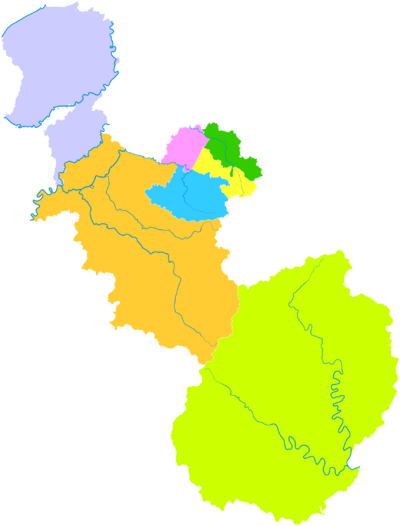
Tiedong
Tiexi
Lishan
Qianshan
Haicheng
(city) Tai'an
County Xiuyan
County |
|||||
| Name | Chinese (S) | Hanyu Pinyin | Population (2003 est.) |
Area (km2) | Density (/km2) |
| Tiedong District | 铁东区 | Tiědōng Qū | 490,000 | 30 | 16,333 |
| Tiexi District | 铁西区 | Tiěxī Qū | 290,000 | 34 | 8,529 |
| Lishan District | 立山区 | Lìshān Qū | 420,000 | 55 | 7,636 |
| Qianshan District | 千山区 | Qiānshān Qū | 260,000 | 503 | 517 |
| Haicheng City | 海城市 | Hǎichéng Shì | 1,130,000 | 2,732 | 414 |
| Tai'an County | 台安县 | Tái'ān Xiàn | 380,000 | 1,393 | 273 |
| Xiuyan Manchu Autonomous County | 岫岩满族 自治县 |
Xiùyán Mǎnzú Zìzhìxiàn |
510,000 | 4,502 | 113 |
Anshan's Economy: China's Steel Capital
Northeast China is a major industrial area, and Anshan is one of its most important cities. Anshan sits on top of a huge amount of China's iron and coal resources. Because of this, the city is known as "China's capital of iron and steel." Before the steel industry grew, Anshan was a small, less important city. As the steel mills got bigger, so did the city. Many other industries also grew around the steel plant, making Anshan a center for heavy industry.
In 1918, the Anshan Zhenzing Iron Ore Company started as a joint Chinese-Japanese business. When Japan took over Northeast China in 1931, these mills became a Japanese-owned company. Anshan then became part of the Japanese puppet state of Manchukuo. More industries developed around the iron and steel mills. Because of its factories, Anshan became a very important industrial hub during World War II. It was often bombed by Allied forces during the war.
By 1942, Anshan's Showa Steel Works could produce 3.6 million tons of steel each year. This made it one of the biggest iron and steel centers in the world.
In 1945, Soviet forces took a lot of equipment from the steel plant. The Chinese government tried to fix the factory, but it was destroyed again during the Chinese Civil War. After the Communist forces won, the mills were rebuilt. The Anshan Iron and Steel Company (Angang) was founded in 1948. For many years, Angang was the largest steel producer in China.
Today, Angang has three steelworks and many other plants that make materials for steel production. It can produce 10 million tons of iron and steel each year. About a quarter of China's total iron ore (about 10 billion tons) is found in Anshan. This means the city will continue to be a key steel producer for a long time.
Other Mineral Riches
Anshan also has many other valuable minerals. The southern and southeastern parts of Anshan are rich in magnesite. The city has about a quarter of all the magnesite in the world. Anshan also has the world's largest supply of talcum, which is one-third of the global supply.
The Xiuyan area of Anshan is famous for its jade. The biggest single jade stone ever found came from Xiuyan. This huge stone has been carved into a Buddha statue and is now a major tourist attraction.
Future Plans for Anshan
Anshan's government made a plan in 2000 to make the city a strong, modern industrial center with lots of tourism. They aimed to greatly increase the city's economic output by 2005. They also wanted to use new technology to improve traditional industries and attract more foreign investment.
Anshan's People: A Diverse Community
Anshan is home to about 3.6 million people. Among them, about 519,400 are ethnic Manchu. This is because northeast China was historically ruled by the Manchu group. Most Manchu people live in or near the Xiuyan Manchu Autonomous County within Anshan.
During the last years of the Qing dynasty, many Han people moved to the northeast to find work. This continued into the 20th century. As Anshan grew into a big industrial city after World War II, its population increased quickly. The new arrivals soon outnumbered the local Manchu people.
Today, Anshan is home to 48 different Chinese ethnic groups. The Han people are the largest group, with over 3 million people. After the Han and Manchu people, the next largest groups are the Hui and the Chaoxian (Korean Chinese) people.
Getting Around Anshan: Transportation Links
Anshan does not have a river or sea port. However, it has the Anshan Teng'ao Airport (AOG), which handles commercial flights. Currently, there are daily flights to major cities like Beijing, Shanghai, Guangzhou, Chengdu, and Nanjing. The airport is about 15 kilometers (9 miles) southwest of the city center. There's also a city terminal where passengers can check in before taking a bus to the main airport. Other large airports nearby are Shenyang Taoxian International Airport (about 90 km north) and Dalian Zhoushuizi International Airport (about 270 km south).
Anshan is connected by major highways. The Shenyang–Dalian Expressway is an eight-lane highway that was the first of its kind in mainland China. The Liaozhong Ring Expressway (G91) also passes close to Anshan. Other expressways connect Anshan's counties to nearby cities.
The city is also part of China's railway network. You can take trains to Beijing, Dalian, and other provinces in northeast China. There's even a direct train to Hong Kong. Since December 2012, the new Harbin–Dalian High-Speed Railway serves Anshan West Railway Station. This line connects Anshan to Dalian in the south and to Shenyang, Changchun, and Harbin in the northeast. It's known as the world's first high-speed rail line in an alpine (mountainous) area. High-speed trains also run from Anshan to Beijing.
For getting around the city, people mainly use buses or taxis. Anshan used to have a tram line, but it has been closed. Because the city center is flat, bicycles are very popular. Most roads have wide bike lanes, often separated from car traffic for safety.
Anshan's Tourist Attractions: Fun Places to Visit
Anshan has been working hard to change its image from just an industrial city to a fun place for tourists. It has many interesting sights to see.
One of the most popular attractions is Qianshan National Park. It's about 18 kilometers (11 miles) southeast of the city. "Qianshan" means "Thousand Mountains," and it's short for "Thousand lotus flower mountains." People say the mountain peaks look like lotus flower petals that fell from the sky. The park covers 44 square kilometers (17 square miles) and is full of both Buddhist and Taoist temples, monasteries, and nunneries. It's special because both religions share the same site. Cars are not allowed inside the park.
One mountain in the park is said to look like the Maitreya Buddha. It's believed to be the largest natural image of Maitreya in the world. Several temples have been built on the hills overlooking it. Near the Buddha, there's also a bird park.
Another main tourist spot is "219 Park." The park's name celebrates the day the People's Liberation Army freed Anshan on February 19, 1948. The park has a beautiful scenic area called Dongshan (East Mountain) and many lakes.
A very special place in the park is the Jade Buddha Palace. This huge Buddhist temple complex covers 22,104 square meters (237,925 square feet). It holds the world's largest Buddha statue made entirely of jade (which is called Serpentine in English). The single jade stone is 6.88 meters (22.6 feet) wide, 4.10 meters (13.5 feet) deep, and 7.95 meters (26.1 feet) high. It weighs a massive 260.76 tons! The front of the stone has a carving of Sakyamuni Buddha, and the back has Guanyin Buddha.
The jade stone was found in 1960 in Xiuyan County. It was declared a national treasure. The Anshan city government hired 120 sculptors who worked for 18 months to carve it. The temple complex opened on September 3, 1996. The building holding the Jade Buddha is 33 meters (108 feet) tall. This height represents the 33 layers of heaven in Buddhism. It is said to be one of the tallest two-story buildings in traditional Chinese style in China.
Anshan also has natural hot spring water spas. There are four spas and hotels where visitors can bathe in the spring water. At Tanggangzi Spa, which was once visited by the Qing Emperors, you can even try a mud treatment. This involves being buried in hot volcanic sand mixed with the spring water. The natural heat from these springs is also used to provide hot steam and water for heating buildings in the area during winter.
- Scenes of Anshan
Learning in Anshan: Universities
The city is home to two large universities:
- Anshan Normal University
- University of Science and Technology, Liaoning
Famous People from Anshan
Many notable people were born or have connections to Anshan:
- Kei Tomiyama (1938–1995), a Japanese actor and narrator.
- Zhang Dejiang (b. 1946), a retired politician who led China's National People's Congress.
- Ann Hui (b. 1947), a famous Hong Kong film director. Her 2006 movie The Postmodern Life of My Aunt was partly filmed in Anshan.
- Guo Mingyi (b. 1958), a kind person who started working at the Anshan Iron and Steel Group and became a philanthropist.
- Chen Xiaoxu (1965–2007), an actress known for playing Lin Daiyu.
- Tang Xiao'ou (b. 1968), a computer scientist who helped start SenseTime.
- Lei Jiayin (b. 1983), an actor.
- Du Jing (b. 1984), a female badminton player and former world champion.
- Zhang Xiaofei (b. 1986), an actress known for her role in Hi, Mom.
- Chen Tao (b. 1986), a footballer.
- Zhang Wenzhao (b. 1987), a footballer.
- Li Jiahang (b. 1987), an actor.
- Li Man (b. 1988), an actress.
- Li Xiaoxia (b. 1988), a female table tennis player and Grand Slam champion.
- Guo Yue, a table tennis player and 2007 women's world champion.
- Ma Long (b. 1988), a male table tennis player, once ranked number one in the world.
- Wang Yanlin (b. 1989), an actor.
- Beiwen Zhang (b. 1990), a Chinese-born American badminton player.
- Xu Mengtao (b. 1990), the 2022 Olympic Champion in aerial skiing.
- Xu Minghao (stage name The8; b. 1997), a member of the popular K-pop group Seventeen.
See also
 In Spanish: Anshan para niños
In Spanish: Anshan para niños







